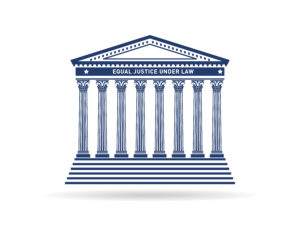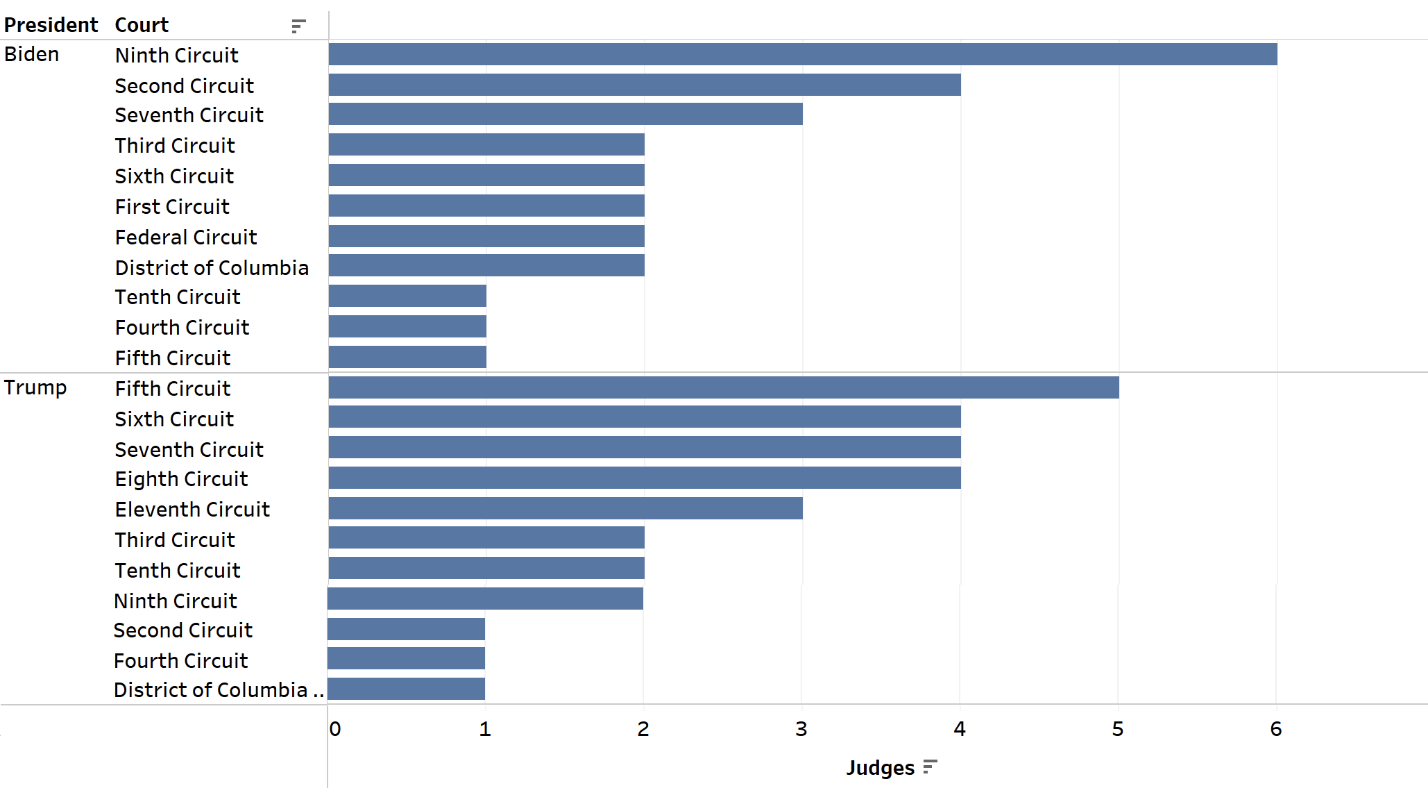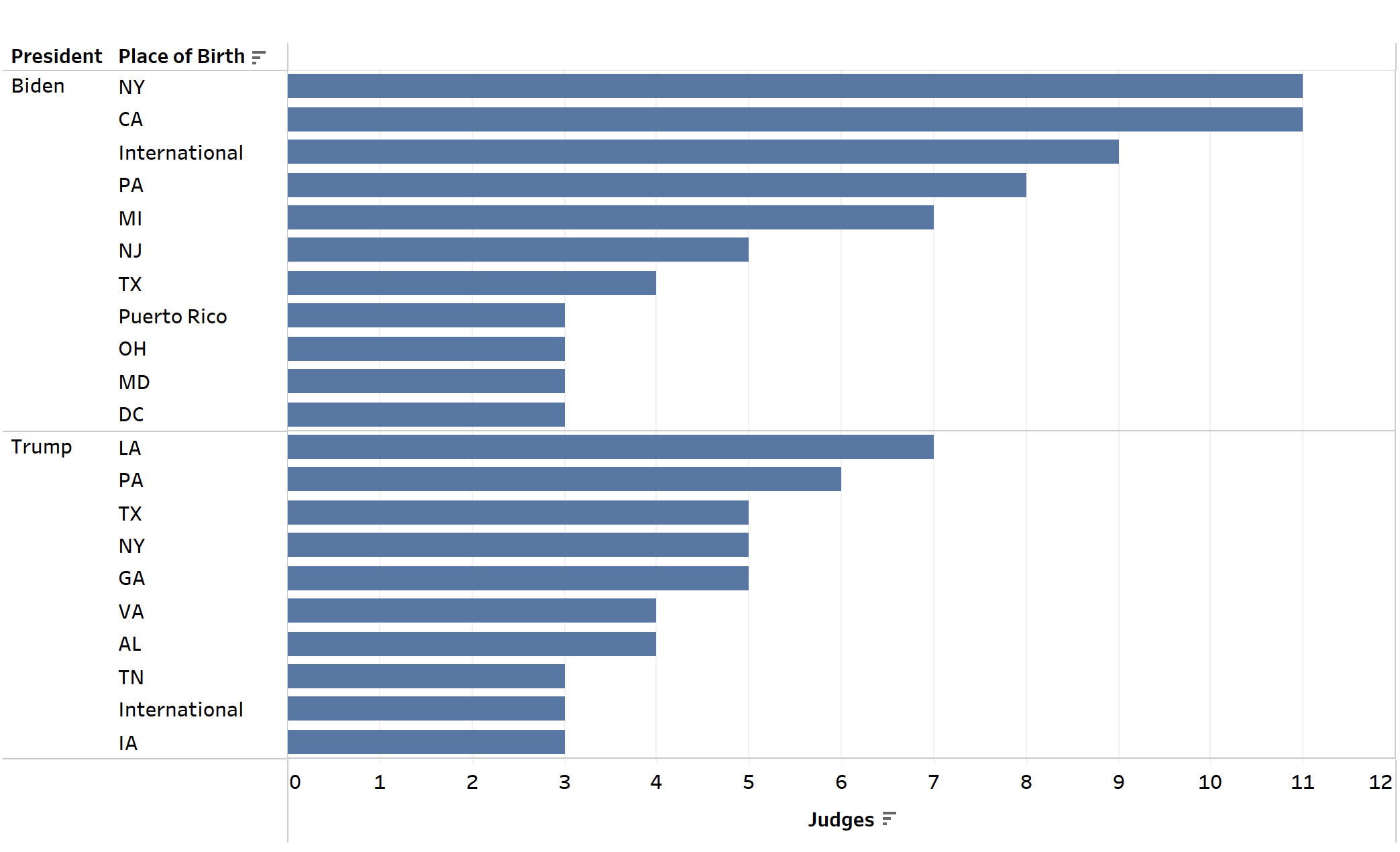A Tale Of Two Presidents
Trump’s and Biden’s confirmed judges, 719 days into both presidencies.
 On April 19, 2021, President Biden released his first slate of judicial nominees.
On April 19, 2021, President Biden released his first slate of judicial nominees.
Along with five district court nominees and two other appeals court nominees, Biden nominated (now) Justice Ketanji Jackson to the D.C. Circuit Court of Appeals. Jackson was confirmed to the D.C. Circuit on June 14, 2021, and less than a year later Jackson was nominated to the U.S. Supreme Court on February 28, 2022. Biden has nominated over 90 judges to the Article III courts to date.
Through President Trump and Biden’s appointments these courts look very different from how they looked when Obama left office at the beginning of 2017.
Trump appointed well over 200 judges through his full term in office. These included 10 seats on the 9th Circuit Court of Appeals in the western U.S., six seats on both the 6th Circuit running through the Midwest and the 5th Circuit in the South.
January 9, 2023, marks 719 days into Biden’s presidency. This article compares Trump’s and Biden’s confirmed judges 719 days into both presidencies in terms of overall number and characteristics.
Courts
Biden had more confirmed judges 719 days into his presidency than Trump had in his, yet Trump had more confirmed appellate judges during the same timeframe.

With Trump’s Supreme Court nominees, Trump had 31 confirmed appellate judges in his first 719 days for a total of 84 Article III judges. Biden had fewer confirmed appellate judges in this length of time with 27 but with 68 district court judges Biden’s total is 95 judges so far.
These 179 combined total judges from these presidents can be broken down along several lines of inquiry. First in terms of the specific courts which were impacted the most beginning with district courts looking at courts with two or more appointees.

Trump’s maximum number of judges in a district court was three at this point in his presidency including in the Western District of Pennsylvania, Western District of Louisiana, and District of Columbia. Biden appointed more than three judges in four instances – with six in New Jersey, and four in each of the Western District of Washington, Eastern District of California, and Eastern District of Pennsylvania.
Looking at appellate courts below the Supreme Court we see the following:

Biden filled the most slots in a circuit with six in the 9th Circuit. Trump had five in the 5th Circuit and four in each of the 6th, 7th, and 8th Circuits.`
Judge Characteristics
Who are these judges? The FJC has a useful dataset that breaks down the judges according to many variables. A starting point is where these judges came from — in particular, where they were born, focusing on three or more judges from a locale.

There are distinct geographic differences between the places of birth towards the top of each president’s lists. Trump had seven judges from Louisiana, six from Pennsylvania, five from Texas and New York, and three born outside of the United States, Biden has 11 from each of New York and California, eight from Pennsylvania, and nine international judges. All in all, Trump had a more even split of judges while Biden’s judges are more clustered at the high and low ends with fewer judges in the middle range.
When we look at the racial/ethnic demographics we see a much more diverse set of judges from Biden than we did from Trump.

Trump’s appointees were primarily white males followed by white females. Only seven judges fell into other backgrounds. Biden on the other hand has vastly more women at the top with the leading demographics white female, African American female, and Hispanic female. So far Biden has only appointed five white men to Article III courts.
Another point of interest is the law schools from which these judges matriculated. First a look at Trump’s judges using percentages of nominees rather than counts to see the relative frequency of the schools. The low cut point for schools was at 2% of appointees.

8.3% of Trump’s appointees went to Harvard Law. Rather than following the traditional route of presidents by appointing judges who graduated from top ranked schools, after Harvard Trump’s nominees came from a more diverse set of schools from around the country. The next most frequent at 7.1% of appointees came from University of Alabama Law. Next, the same frequency of judges, 4.8% came from each of Yale Law, Vanderbilt Law, and Georgia Law.
Next are Biden’s judges.

Biden has followed a more traditional route at the top with 10.8% of nominees from both Harvard and Yale Law. These are followed by NYU Law at 8.6% and University of Virginia Law at 5.4%. Biden had a greater penchant for judges from West Coast schools than Trump with UCLA Law and UC Berkeley Law towards the top. Trump’s first West Coast school, Stanford Law, only appears at a frequency of 2.4%.
Thus, we see that each president sought different types of diversity in judicial appointees as noted by each of these metrics, which makes sense since each president values different characteristics in their judges.
Judges
There are several other categories of interest related to the individual judges. One point of note are the nominees confirmed by a large margin of votes and those confirmed by a small margin.
Biden, for instance had 14 nominees confirmed with four or fewer votes. Those with the smallest vote margins where Judge Bernard Mathis from the 6th Circuit and Judge Jennifer Sung from the 9th Circuit both confirmed by a one-vote margin, followed by Judge Frances Behm from the District Court for the Eastern District of Michigan and Judge John Chun from the Western District of Washington both confirmed by two-vote margins. On the other end of the spectrum the two judges confirmed by the largest margins were Judge Zahid Quraishi for the District of New Jersey who was confirmed with a 65-vote margin and Judge Regina Rodriguez for the District of Colorado confirmed by a 44-vote margin.
Trump had fewer nominees confirmed by four or fewer votes with nine. These included Judge Andrew Oldham for the 5th Circuit and Judge Jonathan Kobes for the 8th Circuit each confirmed by one-vote margins, Judges Gregory Katsas of the D.C. Circuit and Leonard Grasz for the 8th Circuit each confirmed by a two-vote margin, and Justice Brett Kavanaugh confirmed to the U.S. Supreme Court also by a two-vote margin.
Trump had many more nominees confirmed by wide vote margins than Biden. This far into his presidency Trump had 16 judges confirmed by vote margins of 90 votes or more. The widest margins were for Judge David Nye of the District Court for the District of Idaho who was confirmed by a full Senate of 100 votes and each of Judges Thomas Parker for the Western District of Tennessee and Terry Doughty for the Western District of Louisiana both confirmed by 98-vote margins.
Lastly a look at the youngest and oldest nominees from 719 days into each presidency. Trump’s oldest nominee was Judge Mark Bennett of the 9th Circuit born in 1953. Trump’s youngest was Judge Holly Teeter from the District Court for the District of Kansas who was born in 1979. Biden’s oldest confirmed nominees are Judges Jeffrey Hopkins from the Southern District of Ohio and Evelyn Padin for the District of New Jersey who were both born in 1960. Biden’s youngest appointee is Sarala Nagala for the District of Connecticut who was born in 1983.
Lots can be learned about these presidents’ values from the judges they nominate. Article III judges are placed on federal courts for life and so they tend to be the presidents’ most lasting legacies. These judges also get to decide on the constitutionality of these presidents’ policies and have wide discretion to do so. By the end of Biden’s presidency, we will have a fuller picture of how he reshaped the judiciary and of his priorities in who he nominates just as we can glean this from the host of judges that Trump nominated before he left office.
Read more at Empirical SCOTUS….
Adam Feldman runs the litigation consulting company Optimized Legal Solutions LLC. For more information write Adam at [email protected]. Find him on Twitter: @AdamSFeldman.







